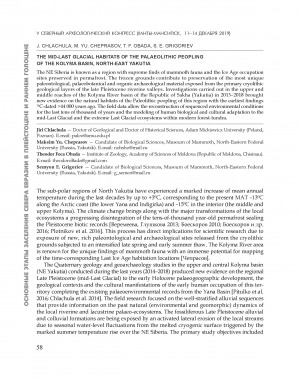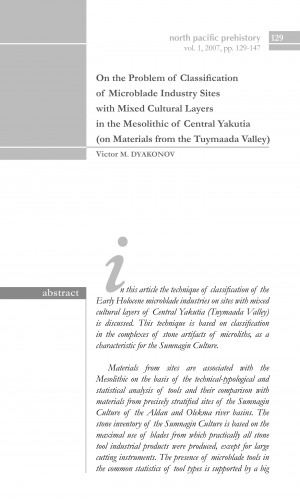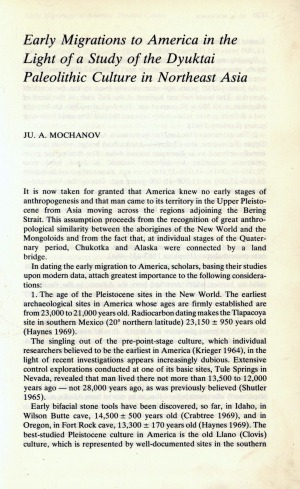Количество страниц: 12 с.
- Общественные науки. Образование > Этнография. Обычаи. Жизнь народа. Нравы,
- Краеведение. Археология. География. Биографии. История > Историческая наука. Историография > Археология,
- НАУКА ЯКУТИИ > ОБЩЕСТВЕННЫЕ НАУКИ > Этнография. Обычаи. Жизнь народа. Нравы,
- НАУКА ЯКУТИИ > КРАЕВЕДЕНИЕ. ГЕОГРАФИЯ. БИОГРАФИИ. ИСТОРИЯ > Историческая наука. Историография > Археология.
Frozen graves of Yakutia, a chronological sequence / S. Duchesne, R. Bravina, V. Popov [и др.] // Вестник археологии, антропологии и этнографии. – 2020. – N 4 (51). – С. 120-130. — DOI: 10.20874/2071-0437-2020-51-4-11.
DOI: 10.20874/2071-0437-2020-51-4-11
Количество страниц: 4 с.
Северо-Восток Сибири известен как регион c важными находками мамонтовой фауны и стоянок древних людей последнего ледникового периода, сохраненных в вечной мерзлоте. Минусовые термические условия содействуют сохранению уникальных палеонтологических, палеоботанических и органических археологических материалов, краткосрочно вымытых на поверхность из первичных криолитических геологических слоев древних речных долин эпохи плейстоцена. Проведенные работы в бассейне верхнего и среднего течения реки Колыма в пределах Республики Саха (Якутия) в 2013–2018 гг. принесли новые, подтвержденные радиоуглеродными датами свидетельства обитания человека эпохи палеолита в этом регионе более чем 44 тыс. л. н. Данные полевых исследований позволяют провести реконструкцию природных условий последних десятков тысяч лет и моделирование биологической и культурной адаптации человека к экстремальным условиям последнего интергляциала и гляциала в поясах современной лесотундры.
The mid-last glacial habitats of the palaeolithic peopling of the Kolyma basin, Nortn-East Yakutia=Следы обитания человека эпохи палеолита в интергляциале бассейна Колымы, северо-восток Якутии / J. Chlachula, M. Yu. Cheprasov, T. F. Obada, S. E. Grigoriev // V Северный археологический конгресс, 11-14 декабря 2019, Ханты-Мансийск : тезисы докладов. – Екатеринбург ; Ханты-Мансийск : Альфа-Принт, 2019. – С. 58-60.
Количество страниц: 19 с.
Работа посвящена проблеме изучения мезолита в Центральной Якутии. Здесь было известно небольшое количество стоянок сумнагинской культуры, характеризующихся смешанными культурными комплексами, и датированных этим временем лишь по аналогиям инвентаря. В работе предложена методика определения раннеголоценовых комплексов в смешанных культурных слоях, основанная на выделении в общих комплексах каменного инвентаря микролитов, в большей степени характерных для сумнагинской культуры. Проведённый анализ позволил выделить сумнагинский культурный комплекс на 11 памятниках Туймаады. На ещё около 25 памятниках, где обнаружены микропластинчатые индустрии, при расширении работ, может подтвердиться предположение о наличии в культурных слоях мезолитического каменного инвентаря
Dyakonov, V. M. On the Problem of Classification of Microblade Industry Sites with Mixed Cultural Layers in the Mesolithic of Central Yakutia (on Materials from the Tuymaada Valley) / Victor M. Dyakonov // North Pacific Prehistory : archaeological studies journal. — 2007. — Vol. 1. — P. 129-147.
Количество страниц: 13 с.
Древнейшие памятники дюктайской культуры найдены и в Северной Америке — на Аляске и прилегающих к ней территориях Канады.В настоящее время у ученых почти не вызывает сомнения предположение, что именно из Северо-Восточной Азии (из Якутии через Чукотку и Аляску) происходило и первоначальное заселение человеком Нового Света. Считается аксиомой, что Америка изначально была безлюдной и что континент был заселен человеком современного физического типа (Homo sapiens) из Азии через области, примыкающие к Берингову проливу, по Берингийскому сухопутному мосту, соединяющему Чукотку с Аляской.
Mochanov, Ju. A. Early migrations to America in the light of a study of the Dyuktai paleolithic culture in Northeast Asia / Ju. A. Mochanov // Early Native Americans : prehistoric demography, economy, and technology. — The Hague ; Paris ; New York : Mouton publishers, 1980. — P. 119-131.



